What is SAP BI and SAP BI tool?
Hello and welcome to my new blog. Please read through my previous article “What is SAP HANA?” for additional information.
This blog provides you with a wealth of knowledge as well as an overview of SAP Business Intelligence (BI).
Overview of SAP BI: What is SAP BI?
SAP Business Intelligence, or SAP BI for short, is a suite of programs developed by SAP SE to simplify the management and analysis of vast amounts of data.
SAP BI offers users access to resources for collecting, archiving, prepping, and analyzing information from multiple sources within an organization.
Its purpose is to empower businesses with useful data so they can make better decisions and optimize operations by providing actionable insights.
SAP BusinessObjects, SAP Business Warehouse, SAP Business Analytics Network (HANA), and SAP Lumira are just a few of the components that make up SAP Business Intelligence (SAP BI). With SAP BusinessObjects customers can access various reporting and analysis tools in one unified environment.
SAP Business Information Warehouse (SAP BW) is the system’s data warehouse component, storing and organizing information gathered from other SAP BI systems.
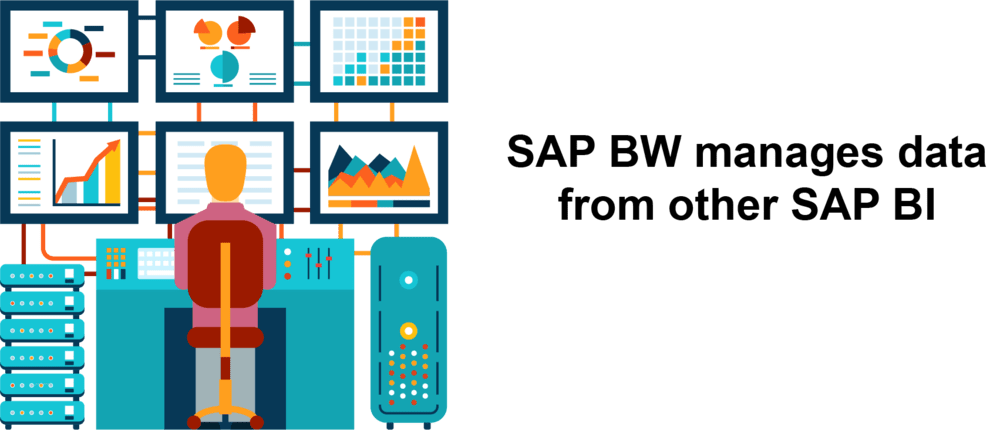
SAP Lumira is a data visualization tool that empowers users to build interactive dashboards and visualizations, while SAP HANA is an in-memory database platform with real-time processing and analytics capabilities.
SAP BI is an all-inclusive data analysis and reporting solution for businesses, providing them with better insight into their data in real time so they can make more informed decisions
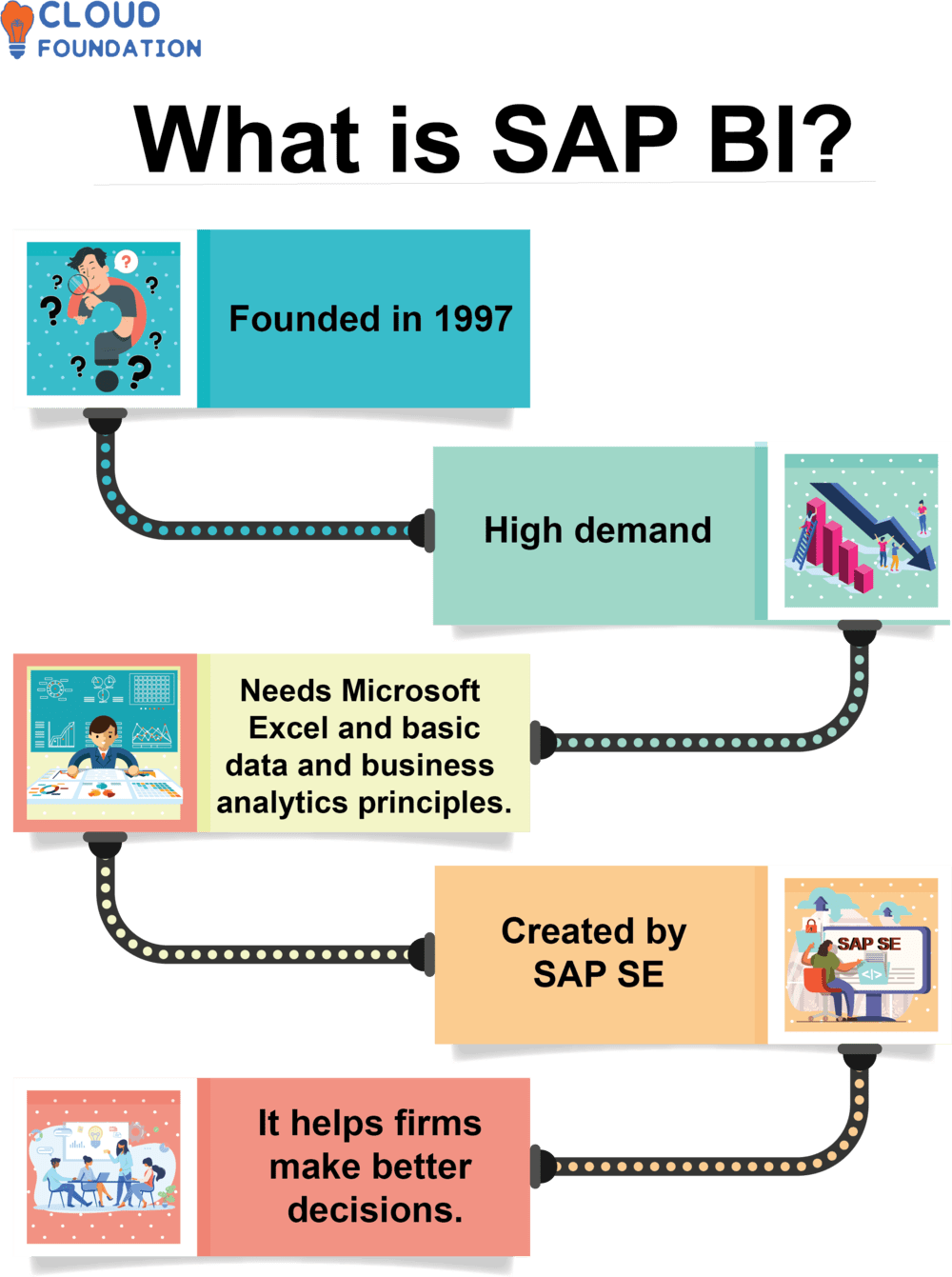
“SAP Business Intelligence offers companies the power to enhance their operations, maximize resources and gain a competitive edge in the market.”
Introduction to SAP BI
SAP SE’s SAP BI (Business Intelligence) suite helps companies manage and analyze data. Utilizing this comprehensive suite, companies can collect, store, convert, and interpret information from multiple sources for actionable insights that can improve operations.
SAP BusinessObjects, SAP BW, SAP HANA, and Lumira are some of the components included in SAP BI that provide centralized data administration and analysis for enterprises.
SAP BusinessObjects offers a suite of tools for reporting, analysis, and visualization. SAP BW acts as SAP BI’s data warehouse storing, extracting, transforming, and loading data.
SAP HANA is an in-memory database platform that offers real-time data processing and analytics. At the same time, SAP Lumira is a self-service data visualization tool that enables users to create interactive dashboards and visualizations.
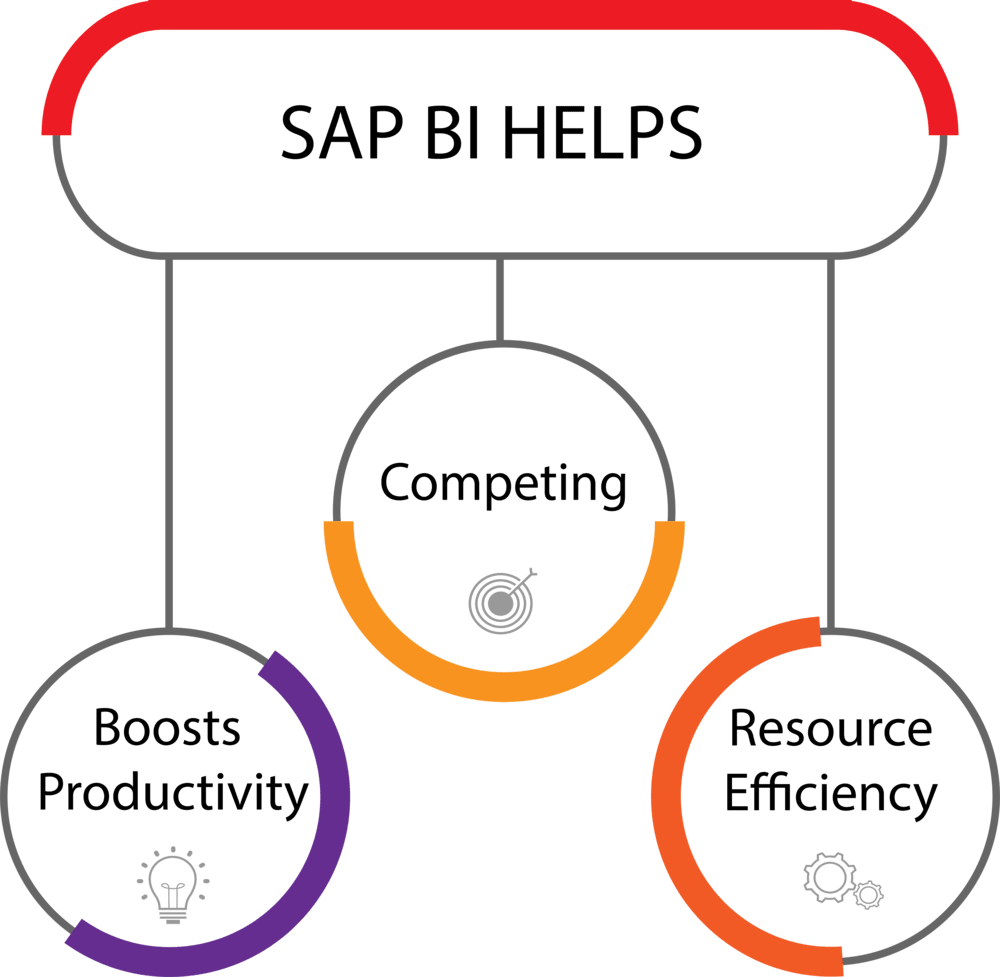
SAP Business Intelligence (BI) assists companies in gaining real-time insights and making educated decisions by managing and analyzing data. SAP BI helps companies boost productivity, resource efficiency, and competitiveness.
Define SAP BI
SAP SE’s SAP BusinessObjects software collects, stores, analyses, and presents data. It offers a multi-component data management and analysis platform that includes BusinessObjects, BW, HANA, and Lumira. SAP BusinessObjects comprises reporting, analytical, and visualization tools.
SAP Business Intelligence’s Data Warehouse. SAP HANA is an in-memory database platform that offers real-time data processing and analytics, while SAP Lumira offers self-service data visualization tools so users can create interactive dashboards and visualizations.
SAP Business Intelligence (BI) delivers real-time business information to help you make informed decisions and optimize processes. BI also enhances resource management, efficiency, and competitiveness by improving resource management, efficiency, and effectiveness.
What does SAP BI do and what is SAP BI used for?
SAP AG’s SAP BI suite integrates data analysis and reporting. This warehousing solution makes it possible for organizations to collect, process, and interpret large amounts of information from ERP systems, databases, spreadsheets, as well as external sources.
SAP BI offers numerous reporting, analysis, visualization, and modeling features. It enables users to create real-time reports, dashboards, and ad hoc queries that can be shared with colleagues or clients.
Furthermore, the software supports predictive analytics, forecasting models, and trend analysis data models for further analysis.
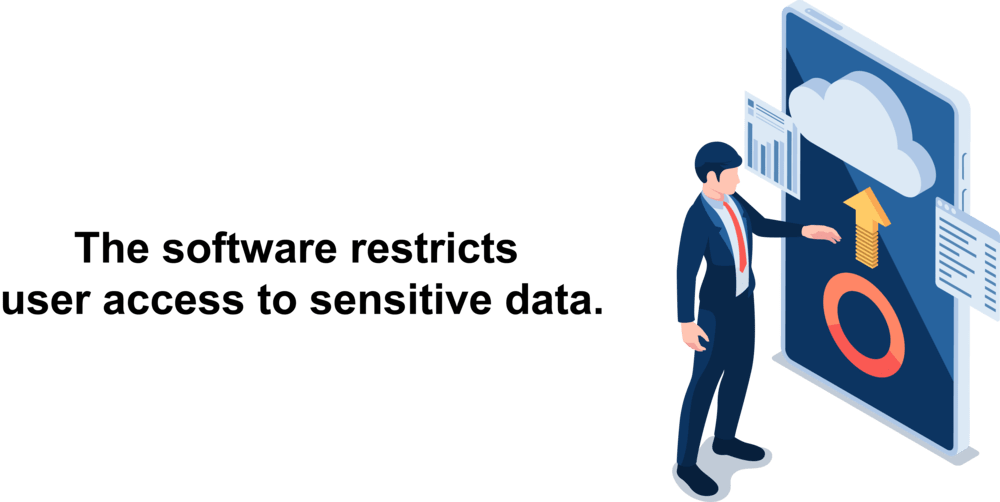
SAP BI is capable of processing, cleansing, and integrating structured and unstructured data from multiple sources. Its advanced security measures protect sensitive information while restricting user access.
As a result, organizations gain valuable insights from their data sets which aid in making more informed business decisions and improving performance.
Organizations utilize SAP BI (Business Intelligence) for several reasons, such as:

Reporting and Analysis: SAP BI provides users with reports that are generated and analyzed in real time from various sources, giving them valuable insights into key performance indicators (KPIs), trends, and patterns. The software offers various reporting options such as standard reports, ad hoc reports, and dashboards.
Data Integration: SAP BusinessObjects users can extract, transform and load data from multiple sources into a data warehouse to guarantee consistency and accuracy. The software offers powerful data integration features that reduce duplication of information, enhance data quality and protect data integrity.
Data Modeling: SAP BusinessObjects users can construct and maintain data models that define the relationships among various data elements. These models can be utilized for data analysis, forecasting, and predictive modeling – empowering organizations to make data-driven decisions.
Predictive Analytics: SAP BI provides advanced analytical capabilities such as predictive analytics and data mining, which allow users to detect trends, patterns, and relationships in their data. This enables organizations to make more accurate forecasts and predictions which in turn leads to improved overall business performance.
Business Planning and Budgeting: SAP Business Intelligence provides budgeting, planning, and forecasting tools that enable users to create detailed budgets and projections based on historical data and trends.
Organizations use SAP BI to gain insights into their data, make informed decisions and boost overall business performance.
What are SAP BI business objects?
SAP BI (Business Intelligence) is a collection of tools that enables businesses to collect, analyze and report on business data.
SAP BusinessObjects is an expansive platform with features such as data integration, reporting, dashboards, and analytics.
SAP BusinessObjects itself consists of a collection of reporting and analytics tools within the suite of applications provided by SAP BusinessObjects.
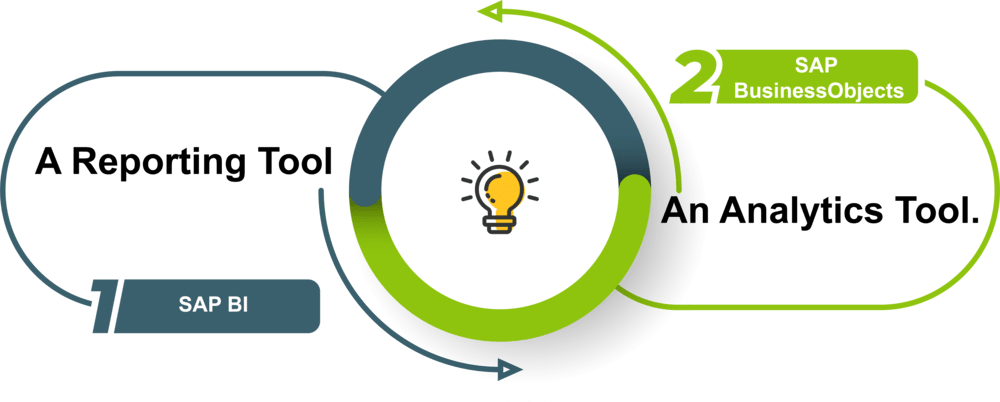
In conclusion, SAP BI is an extensive suite of tools that includes SAP BusinessObjects – a reporting and analytics application. Both products are designed to assist businesses in better comprehending and exploiting their business data.
SAP BI Reporting
SAP Business Intelligence (BI) reporting collects, analyses, and presents data to aid businesses in making decisions. Organizations can utilize data from databases or apps using SAP BI reporting.
SAP BusinessObjects reporting uses SAP BusinessObjects to generate reports and dashboards that give users a comprehensive view of their business operations. Executives, managers, and analysts can customize these reports for even greater insight.

SAP BI reporting offers organizations numerous advantages:
Discover their business operations and performance.
Recognize data trends and patterns.
Monitor key performance indicators (KPIs) and metrics.
Armed with these insights, make informed decisions.
How does SAP BI work?
SAP Business Intelligence (BI) is a suite of tools and applications that assist businesses in collecting, analyzing, and reporting on their business data.
SAP Business Intelligence (BI) works by connecting to databases, spreadsheets, and other data sources and then turning that information into useful information that can be used for decision-making. On average, these steps make up the SAP BI process:

Data Extraction: SAP BI collects data from various sources, such as transactional databases, data warehouses and spreadsheets.
Data Transformation: Once the extracted information has been standardized into a standard format and cleaned up to guarantee its accuracy and completeness, SAP BI performs data cleansing to guarantee its accuracy and completeness.
Data Modeling: SAP BI creates a data model to illustrate how the information will be stored and organized within the system.
Data Analysis: SAP BI offers several tools such as dashboards, reports, and ad hoc analysis to help users comprehend and explore data.
Data Visualization: SAP BI provides users with interactive visualizations to explore data and identify patterns and trends.
Data Reporting: SAP BI offers various reporting tools that enable users to craft reports and send them off to key stakeholders.
SAP Business Intelligence makes it simpler for organizations to make better decisions by providing them with real-time access to information, insights, and a powerful real-time data transformation feature that allows users to turn vast amounts of data into actionable knowledge that can enhance business operations.
Why SAP BI and what are the benefits of SAP BI?
SAP Business Intelligence (BI) tools and applications enable companies to collect, analyze, and report on business data. SAP BI integrates with databases, spreadsheets, and other sources of information and transforms them into useful decision-making data.
To accomplish this task, SAP BI follows these steps:
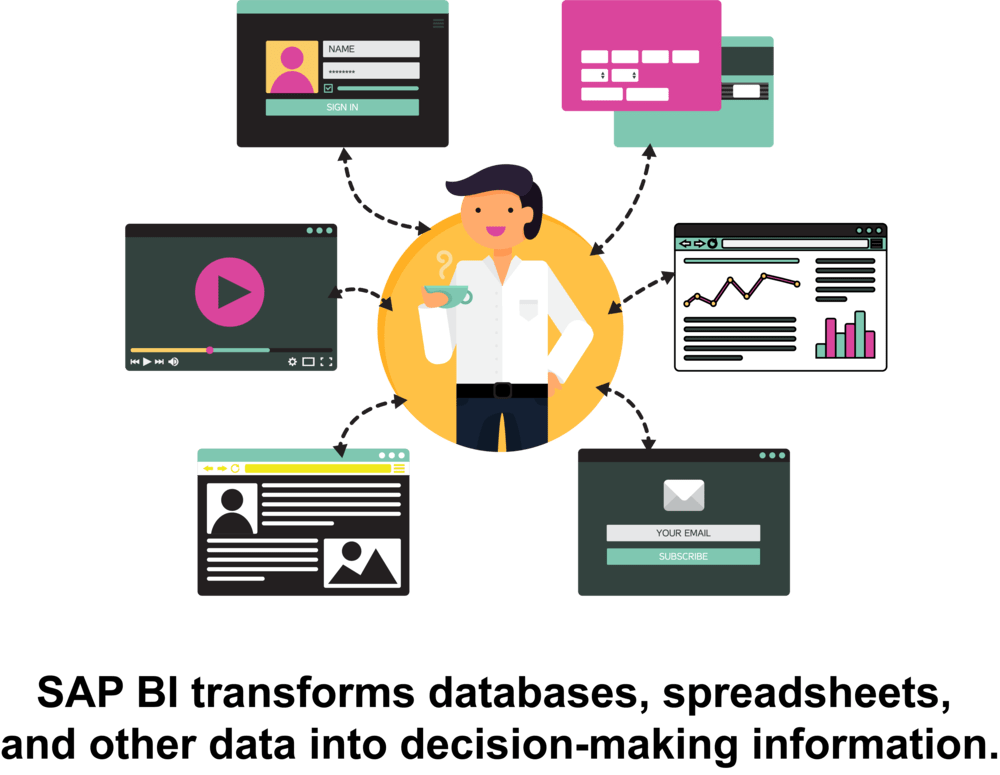
SAP Business Intelligence extracts data from transactional databases, data warehouses and spreadsheets and formats it for accuracy and completeness.
To organize and store this extracted information using a data model is key for SAP BI.
Dashboards, reports and ad hoc analysis allow users to comprehend and explore data in SAP BI.
SAP BI allows them to construct interactive representations to spot patterns and trends.
SAP BI’s reporting features enable users to produce reports that can be shared with stakeholders.
SAP BI offers real-time data, insights and analytics to enhance decision-making. It transforms large datasets into actionable insights that increase business value.
Businesses can reap many rewards from using SAP BI.

SAP BI customers can make better decisions in real-time through insights and analytics, thanks to real-time insights and reporting.
SAP BI Improves Operational Efficiency by streamlining data management and analysis procedures, decreasing the time required to collect, transform, and analyze data.
SAP Business Intelligence Increased Agility SAP BI provides real-time insights into business processes, allowing companies to adjust quickly in response to changing market conditions and client demands.
Improved Communication and Determination-Making Due to More Cooperation SAP BI allows users to communicate and share insights and reports with team members and stakeholders.
SAP BI’s Scalability Makes It Ideal for Businesses with Sophisticated Data Management Requirements.
SAP Business Intelligence can give businesses a competitive advantage by improving their capacity to adapt quickly to changing market conditions and streamlining decision-making processes and internal efficiencies.
Advantages of SAP BI
SAP BI offers several advantages over other data management platforms:

Centralized Data Management: SAP BI consolidates data from multiple sources into one centralized platform, making large amounts of information easier to organize and analyze.
Reporting Customization: SAP BI allows users to design customized reports and dashboards tailored to their individual requirements.
Scalability: Built for large amounts of data, SAP BI can grow along with your business as it grows.
User-Friendly Interface: which makes data access and analysis simple for users.
Improved Collaboration: With SAP BI, users can collaborate and share insights and reports with team members or stakeholders, which enhances communication and decision-making processes.
What is SAP BI Software and How to use SAP BI?
SAP Business Intelligence software tools and applications enable companies to collect, organize, and analyze business data. It includes data warehousing, modeling, extraction, transformation, analysis, reporting, and dashboarding capabilities.
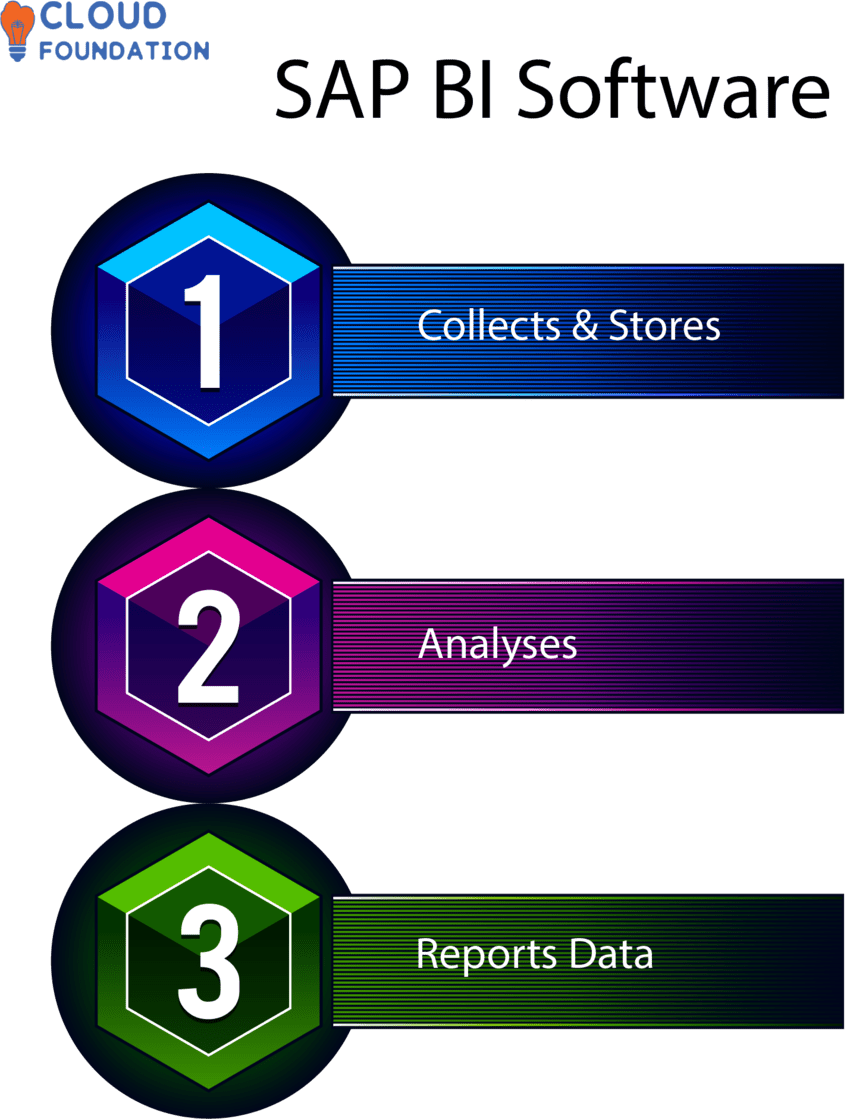
SAP BI beginners goal is to give decision-makers real-time visibility into an organization’s activities. Through SAP BI basics, users can visualize and analyze data from databases, spreadsheets, and other sources.
SAP Business Intelligence software simplifies data administration and analysis by centralizing it, making handling large datasets much simpler. It enables users to generate customized reports and dashboards.
SAP BI assists enterprises in making better decisions, streamlining data management processes, and gaining operational insights.
Using SAP BI effectively requires the following steps:
Planning: Define the project’s business requirements and scope.
Data Extraction: Gather data from various sources like databases, files, spreadsheets, etc., then load it into SAP BI system.
Data Modeling: Utilizing data modeling techniques such as creating dimensions, hierarchies, and measures, transform raw data into useful information.
Data Transformation: Prep the data for analysis with data transformation methods like filtering, cleaning, aggregation, and merging.
Data Analysis: Utilize SAP BI’s various analytical tools and techniques, such as OLAP (Online Analytical Processing) and data mining, to analyze the data.
Reporting and Dashboarding: Leverage SAP BI tools to construct reports and dashboards that showcase insights gained from your analyses.
Share and Collaborate: Distribute reports and dashboards to stakeholders, then work with team members to make informed decisions.
SAP BI offers training, certifications, and documentation for users to help them master the software. Obtain SAP BI training and certification so you can use it productively.
SAP BI Services
SAP Business Intelligence (BI) services are a suite of tools, technologies and services provided by SAP AG to assist organizations in managing their data more effectively and making better business decisions.
SAP Business Intelligence services offer a comprehensive platform for data warehousing, integration, reporting and analysis.
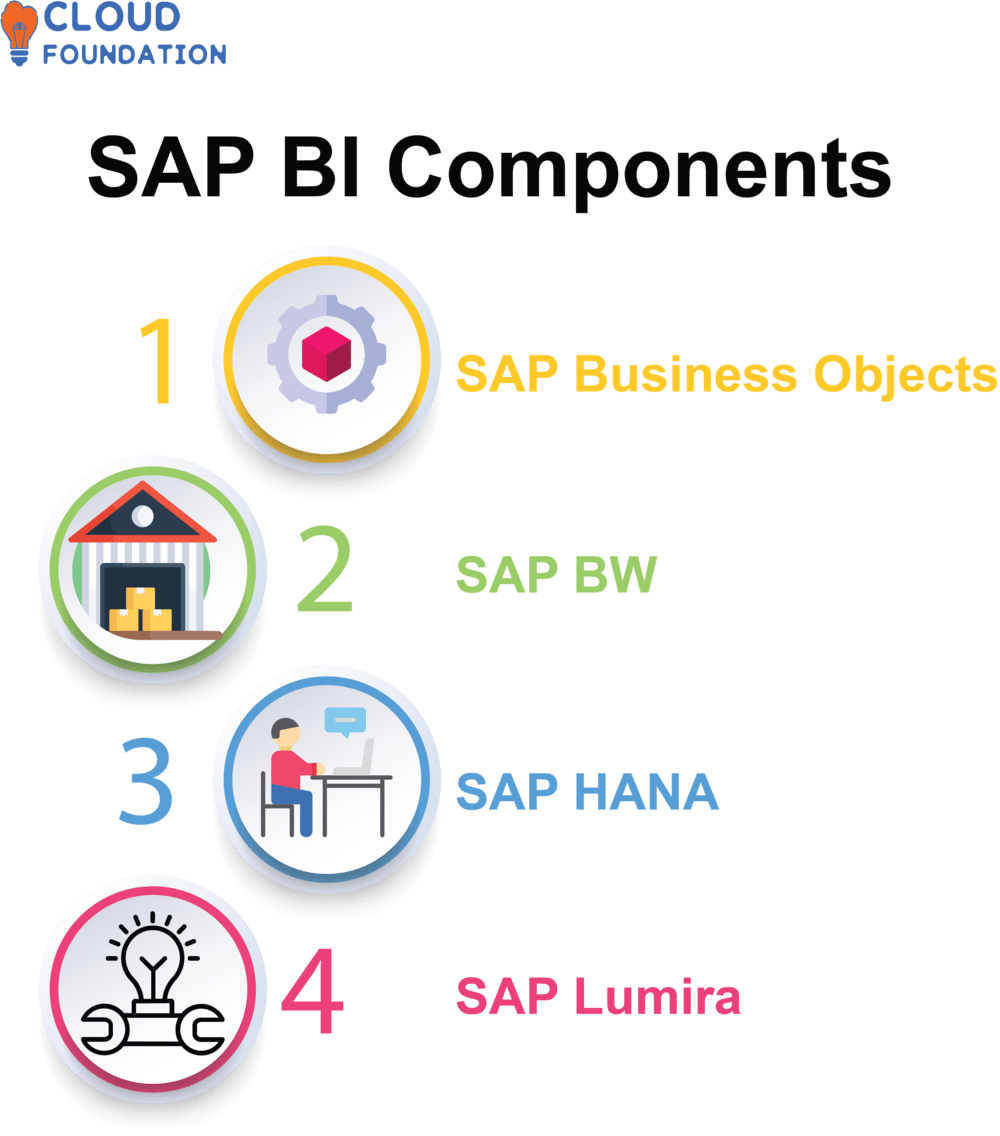
These products provide various features and functionalities that enable organizations to collect, store, and analyze data from multiple sources in order to gain insights into their business operations.
SAP Business Intelligence services enable organizations to create interactive dashboards, reports and data visualizations that give real-time insight into business performance.
They can automate data integration processes, making combining information from various sources simpler and creating a single point of truth for business reporting and analysis.
What are the best ways to learn SAP BI?
SAP BI (Business Intelligence) training requires both book smarts and practical expertise.
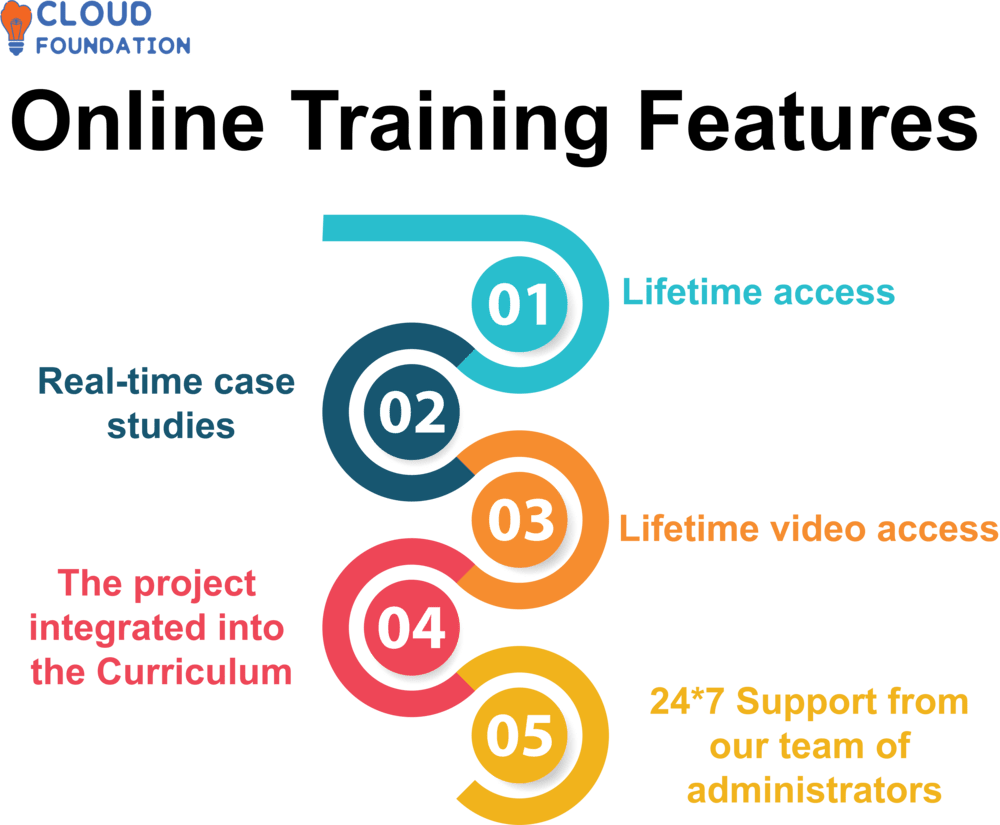
Attending SAP BI training is an ideal way to become familiar with the software. Cloud Foundation will provide access to knowledgeable teachers who can answer questions and guide you through your learning journey.
Learn the fundamentals of SAP BI blogs and taking advantage of the online SAP BI course.
Put your newfound skills to the test through SAP BI training videos on SAP BI; these tutorials offer invaluable insight into how it functions in practice scenarios.
CloudFoundation offers you a convenient platform to ask questions, get support and stay up to date. Be familiar with certification requirements and prepare yourself for the SAP BI certification exam with CloudFoundation’s help.

Saniya
Author
“Life Is An Experiment In Which You May Fail Or Succeed. Explore More, Expect Least.”



